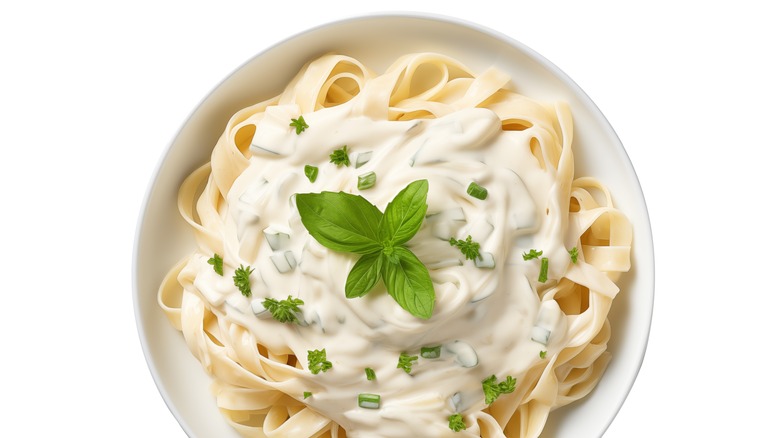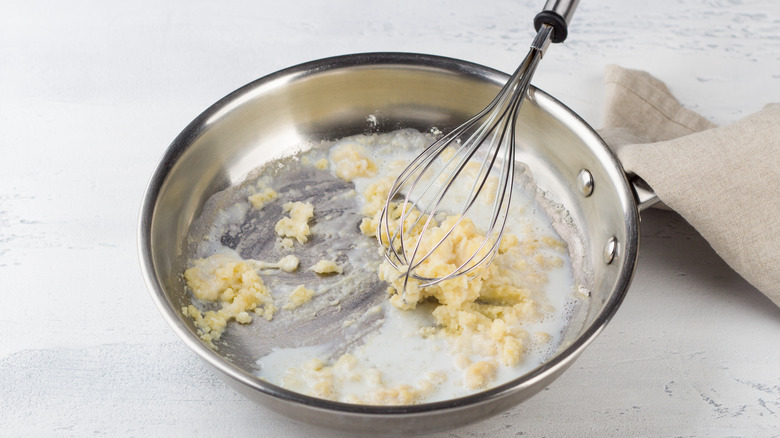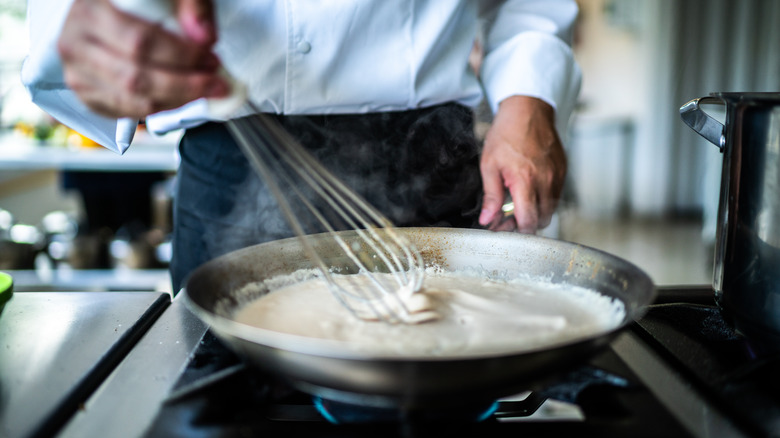The Milk Swap That's So Easy To Make For A Lighter Pasta Sauce
Whether you're a die-hard Alfredo fan or you're in the mood for stovetop mac and cheese (which we think is better than baked), you can't go wrong with a rich, creamy white sauce paired with your favorite pasta. The trouble is, most creamy, dairy-based sauce recipes can feel a little too heavy when they're made with cream. If you're craving a lighter linguini, don't stress because there's an easy milk swap to make a lighter pasta sauce: Use 2% milk instead of whole milk or cream.
There are two approaches to making a creamy white sauce for pasta. The first is reducing the milk or cream until it gets thick enough to qualify as sauce, and the second is using a roux-based cream sauce (also known as a bechamel). The easiest way to lighten up a pasta recipe with lower-fat milk is to use the second approach, that way you're not relying solely on fat in the dairy to thicken the sauce. That's not to say you can't use 2% milk in a reduction sauce, just be prepared to thicken it a little differently.
Make a lighter bechamel
Even if you don't know the fancy name for roux-based sauces, you've probably made a bechamel if you like pasta with white sauce. This royal-based mother sauce is extremely simple to create; all you have to do is mix equal parts of fat and flour to make a "roux," and then whisk in the milk or cream. When the sauce comes up to gelatinization temperature, which is around 120 to 140 degrees Fahrenheit, the starch molecules expand and thicken the sauce. This is important to know when it comes to creating a lighter pasta sauce because you can get away with using lower-fat dairy since the starch is doing most of the heavy lifting. In fact, you don't even need fat at all to make a roux-based sauce, just some tasty cooking liquid like chicken stock, which is how gravy is made. For white sauce, however, you need some sort of dairy to get the right color and mouthfeel.
Bechamel made with 2% milk will be a little thinner and lighter than one made with whole milk or cream, which is perfect for a weeknight chicken alfredo pasta recipe. The difference, besides the fat and calorie count, is that fat suspended in the milk or cream makes the liquid thicker. So the less fat there is in the dairy, the thinner the resulting sauce will be.
Thickening sauce by reduction
Making a lighter pasta sauce with low-fat milk gets a little trickier when it comes to reduction-style sauces. If you have a recipe that calls for heavy cream but you'd like to lighten it up with 2% milk, it's going to take a little finessing. The most important thing to keep in mind is that milk does not have the same fat content and viscosity as cream, so it won't behave the same way when you're trying to reduce it in a pan for sauce. In this respect, you won't be able to finish a sauce with milk like you could with cream, for instance, without getting watery results.
Instead of swapping 2% milk one-to-one for cream, there are a few methods to try. First, if you must reduce the sauce, use more milk than you would cream. Let the sauce cook down until most of the water has evaporated away and you'll eventually get a thick sauce; it will just take longer than cream. Another approach is to simply add another type of fat, like a tablespoon of sour cream or grated cheese. Finally, you can also whisk in an egg yolk, which will thicken the sauce as it cooks — just be sure to do it over low heat so that you don't end up with watery scrambled eggs instead of sauce. Don't be afraid to experiment with any of these techniques or a combination of all of them, until you find the right balance of a lighter sauce with full flavor and mouthfeel.


